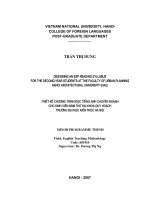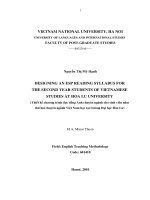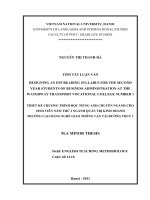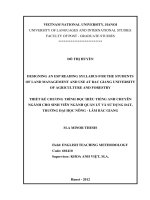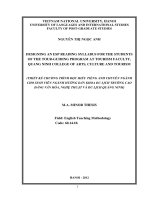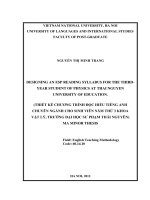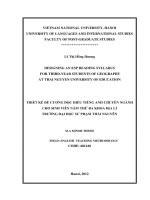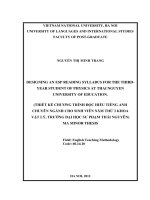Designing an ESP Reading Syllabus for the students of Land Management and Use at Bac Giang University of Agriculture and Forestry = Thiết kế chương trình đọc hi
Bạn đang xem bản rút gọn của tài liệu. Xem và tải ngay bản đầy đủ của tài liệu tại đây (1.05 MB, 75 trang )
VIETNAM NATIONAL UNIVERSITY, HANOI
UNIVERSITY OF LANGUAGES AND INTERNATIONAL STUDIES
FACULTY OF POST - GRADUATE STUDIES
*************************
ĐỖ THỊ HUYỀN
DESIGNING AN ESP READING SYLLABUS FOR THE STUDENTS
OF LAND MANAGEMENT AND USE AT BAC GIANG UNIVERSITY
OF AGRICULTURE AND FORESTRY
THIẾT KẾ CHƯƠNG TRÌNH ĐỌC HIỂU TIẾNG ANH CHUYÊN
NGÀNH CHO SINH VIÊN NGÀNH QUẢN LÝ VÀ SỬ DỤNG ĐẤT,
TRƯỜNG ĐẠI HỌC NÔNG - LÂM BẮC GIANG
M.A MINOR THESIS
Field: ENGLISH TEACHING METHODOLOGY
Code: 601410
Supervisor: KHOA ANH VIỆT, M.A.
Hanoi - 2012
4
TABLE OF CONTENTS
DECLARATION
i
ACKNOWLEDGEMENTS
ii
ABSTRACT
iii
LIST OF ABBREVIATIONS
iv
LIST OF CHARTS AND TABLES
v
TABLE OF CONTENTS
vi
PART A: INTRODUCTION
1
1. Rationale
1
2. Aims and objectives
2
3. Scope of the study
2
4. Methods of the study
3
5. Design of the study
3
PART B: DEVELOPMENT
4
CHAPTER 1: LITERATURE REVIEW
4
1.1. An overview of ESP
4
1.1.1. Definition and characteristics of ESP
4
1.1.2. Classification of ESP
6
1.2. An overview of syllabus design
7
1.2.1. Definition of syllabus
7
1.2.2. Syllabus design
9
1.2.3. Approaches to ESP syllabus design
9
1.2.3.1. Language-centred approach
9
1.2.3.2. Skills-centred approach
10
1.2.3.3. Learning-centred approach
10
1.2.4. Types of syllabus
10
1.2.4.1. Structural/grammatical syllabus
11
1.2.4.2. Situational syllabus
12
5
1.2.4.3. Functional-notional syllabus
12
1.2.4.4. Topic or content-based syllabus
14
1.2.4.5. Skills-based syllabus
14
1.2.4.6. Task-based syllabus
15
1.2.5. Shapes of syllabus
16
1.2.6. Steps to design a syllabus
17
1.2.6.1. Needs analysis
17
1.2.6.2. Goals and objectives setting
18
1.2.6.3. Content specification
18
1.2.6.4. Syllabus organizing
19
1.3. Reading in ESP
20
1.3.1. Definition of reading
20
1.3.2. Reading skills in ESP
21
1.4. Summary
22
CHAPTER 2: NEEDS ANALYSIS AT BUAF AND THE RESEARCH
METHODOLOGY
23
2.1. The ESP teaching and learning context at BUAF
23
2.2. The target students
24
2.3. The English staff at BUAF
24
2.4. The materials
25
2.5. The study
25
2.5.1. The subjects
25
2.5.2. Instruments for collecting data
26
2.6. Summary
27
CHAPTER 3: DATA ANALYSIS AND DISCUSSION
28
3.1. Needs perceived by the English teachers, the subject teachers and
the target students
28
3.1.1. Attitude towards the necessity of an ESP reading syllabus for the
second year students of Land Management and Use
28
6
3.1.2. Opinions on the objectives of the ESP reading course
28
3.1.3. Opinions on needed topics in the ESP reading syllabus
29
3.1.4. Opinions on needed grammar items in the ESP reading syllabus
30
3.1.5 Opinions on needed reading skills and reading exercises in the ESP
reading syllabus
30
3.1.6. Opinions on types of reading skills and reading exercises in each
unit.
31
3.1.7. Opinions on the number of units in the ESP reading syllabus
32
3.2. Summary
32
CHAPTER 4: THE PROPOSED SYLLABUS FOR THE STUDENTS OF
LAND MANAGEMENT AND USE AT BUAF
34
4.1. Aims and objectives of the ESP reading syllabus
34
4.2. Type of the ESP reading syllabus
34
4.3. Content in the ESP reading syllabus
35
4.3.1. Topics in the syllabus
35
4.3.2. Reading skills and reading exercises in the syllabus
35
4.3.3. Grammar and structures in the syllabus
37
4.4. Time allocation of the ESP reading syllabus
37
4.5. Organization of the ESP reading syllabus
37
4.6. The proposed ESP reading syllabus for the second-year students of
Land Management and Use at BUAF
38
4.7. Sample unit
38
4.8. Summary
38
PART C: CONCLUSION
39
1. Conclusions
39
2. Limitations
40
3. Suggestions for further study
40
REFERENCES
41
APPENDICES
I
7
LIST OF ABBREVIATIONS
EAP: English for Academic Purposes
EBE: English for Business and Economics
EEP: English for Educational Purposes
EFL: English as a foreign language
EOP: English for Occupational Purposes
ESP: English for Specific Purposes
ESS: English for Social Sciences
EST: English for Science and Technology
GE: General English
BUAF: Bac Giang University of Agriculture and Forestry
8
LIST OF CHARTS AND TABLES
Chart 1: The English teachers, the subject teachers and the target students‟ attitude
towards the necessity of an ESP reading syllabus
Chart 2: The English teachers‟ and the target students‟ opinions on types of reading
skills and reading exercises in each unit
Chart 3: The English teachers‟ opinions about the appropriate number of lessons
for the syllabus
Table 1: The English teachers and the target students‟ opinions on the objectives of
the ESP reading course
Table 2: The English teachers, the subject teachers and the target students‟ choice
of topics relating to Land Management and Use
Table 3: The English teachers‟ choice of the grammatical structures in the reading
ESP syllabus
Table 4: The English teachers and the target students‟ choice of reading skills and
reading exercises in the ESP reading syllabus
Table 5: The proposed ESP reading syllabus for the second-year students of Land
Management and Use at BUAF
9
PART A: INTRODUCTION
1. Rationale for choosing the topic
English is now considered to be one of the most popular languages in the
world. In Vietnam, it has been more and more widely used and occupied an
especially important status in the development of international relationship. More
importantly, English has an influence on our education curriculum as a compulsory
subject.
English for Specific Purposes (ESP) has developed as an independent
discipline apart from general English, and it has gained popularity throughout the
world, especially in tertiary education where there is a great variety of majors. Fully
aware of the importance of the English language teaching and learning in general
and ESP in particular, BUAF has introduced ESP courses into the curriculums of
four undergraduate programs, including Accounting, Animal Science and
Veterinary Medicine, Crop Science, and Land Management and Use. In the context
of BUAF, 4 year program students with university training level take the
compulsory General English (GE) course with 7 credits. After finishing their GE
course, they are supposed to take the ESP course of 2 credits. According to the
training curriculum, the ESP is to be delivered in the fourth semester of the second
academic year after three semesters of GE. At this time the students majoring in
Land Management and Use at BUAF are at the end of their second semester and our
ESP teachers are facing a lot of difficulties due to the lack of an appropriate ESP
teaching syllabus. In fact, there is not an available ESP syllabus of Land
Management and Use for our ESP teachers. As far as I know, at other institutions
providing the Land Management and Use major, the materials used for the ESP
course are selected by teachers of English from different sources and they use these
materials as their syllabus for lesson plans. As an English teacher, I was in charge of
designing a syllabus and teaching materials for students of Land Management and
Use. It is clear that a syllabus contributes to the success and fulfills the objectives of
10
an ESP course. Therefore, designing an appropriate ESP syllabus for the students of
Land Management and Use at BUAF is an urgent task.
More importantly, it is believed that the ability to read and comprehend the
written documents is considered as one of the most important factors of success at
tertiary education level. Accepting the fact that reading skill is of great importance
for all students, ESP teachers have been paying attention to the reading skill as it is
the most important skill needed for ESP students‟ future academic career.
Seeing the point, the author is encouraged to undertake this study entitled
“Designing an ESP Reading Syllabus for the students of Land Management and
Use at Bac Giang University of Agriculture and Forestry”.
2. Aims and Objectives
The study aims at designing an appropriate ESP reading syllabus for the
second-year students majoring on Land Management and Use at Land Resources
and Environment Department at BUAF. To achieve this aim, three following
objectives are set to be obtained.
- To get an overview of the theories related to ESP reading and syllabus
design;
- To conduct a needs analysis to identify the students‟ learning situation, the
learning needs perceived by the teachers who are responsible for the ESP course,
the subject teachers, and the second-year students of Land Management and Use;
- To propose an appropriate ESP syllabus for the target students based on the
relevant theories and the needs analysis.
It is hoped that the findings of this study will be of some benefits to the
teaching ESP to the second year students of Land Management and Use at BUAF.
3. Scope of the study
The scope of this study is limited to a study on designing an ESP reading
syllabus for the second - year students of Land Management and Use at BUAF. It is
conducted with the second year students of Land Management and Use, subject
teachers and English teachers within BUAF context. Within the scope of a minor
11
thesis, only the basic theories related to ESP reading and syllabus design are
presented. Other approaches to syllabus designs intended for students and other
subjects at any other levels of English language proficiency would be beyond the
scope.
4. Methods of the study
For this study the following approaches were adopted. First, relevant
literature and studies were reviewed in order to get in-depth information. Second,
the results were surveyed through questionnaires. Finally, the information obtained
from the survey was analyzed and checked against information obtained from
literature and other sources.
5. Design of the study
The thesis is organized into:
Part A, introduction, presents the rationale, aims and objectives, scope, methods and
the design of the study.
Part B, development, includes three chapters:
Chapter 1 reviews theoretical backgrounds relevant to the research topic including
the overview of ESP, syllabus design, needs analysis and reading theories;
Chapter 2 deals with the methodology describing situational analysis, subject of the
study and instruments for collecting data;
In chapter 3 the findings and analysis of the results collected from the survey are
presented;
Chapter 4 proposes a reading syllabus for the second-year students of Land
Management and Use basing on the findings of the study.
Part C, conclusion, presents conclusion of the study, points out some limitations and
proposes some further suggestions for research on the topic.
12
PART B: DEVELOPMENT
CHAPTER 1: LITERATURE REVIEW
1.1. An overview of ESP
1.1.1. Definitions and characteristics of ESP
Although ESP now is a really familiar concept in English Language
Teaching, there is not a universal applicable definition of ESP. It has been defined
by different researchers and scholars from different points of views.
Hutchinson and Walter argue that ESP should be seen as an approach to
language learning, which is based on learner need, not as a product. They mean
ESP does not involve a particular type of language, teaching material or
methodology. It is the view of these authors that the foundation of ESP involves the
learners, the language required and the learning context, which are based on the
primacy of needs in ESP. According to them “The foundation of all ESP is the
simple question: Why does this learner need to learn a foreign language? From this
question will flow a whole host of further questions, some of which will relate to
the learners themselves, some to the nature of the language the learners will need to
operate, some to the given learning context” (Hutchinson and Walter, 1987: 19). On
the whole, they conclude ESP is “an approach to language teaching in which all
decisions as to content and method are based on the learner's reason for
learning"(Hutchinson and Walter, 1987:19).
Needs analysis is also mentioned in many authors‟ definitions of ESP.
Robinson (1991:3), while discussing the criteria of ESP, mentions the element of
students‟ needs. She believes that ESP courses develop from a need analysis “which
aims to specify as closely as possible what exactly it is that students have to do
through the medium of English” (cited in Dudley-Evans and St John, 1998: 3).
Supporting these ideas, Richards et al. (1992:125) define the parent
discipline of ESP as „the role of English in a language course or programme of
instruction in which the content and aims of the course are fixed by the specific
needs of a particular group of learners‟.
13
Dudley-Evans agrees with the above authors and scholars when he theorizes
“English for specific purposes (ESP) has tended to be a practical affair, most
interested in investigating needs, preparing teaching materials, and devising
appropriate teaching methodologies. ” (2001:ix).
Although there have been many definitions of ESP given by different authors,
the Strevens‟ definition seems to cover detailed characteristics of an ESP course. He
identifies and makes a distinction between its absolute and variable characteristics:
Four absolute characteristics are:
1- designed to meet specified needs of the learner;
2- related in content (that is in its themes and topics) to particular disciplines,
occupations and activities;
3- centered on language appropriate to those activities in syntax, lexis,
discourse, semantics and so on, and analysis of the discourse;
4- in contrast with „General English‟.
Two variable characteristics are:
1- may be restricted as to the learning skills to be learned (for example
reading only);
2- may not be taught according to any pre-ordained methodology.
(Strevens: 1988:1-2 cited in Dudley-Evans and St John, 1998:3)
After that, Dudley-Evans and St John (1998: 4-5) offer a definition of ESP
stating that although ESP could be used with young adults in the setting of a
secondary school, it is likely to be used with adult learners at tertiary level
institution or in a professional work situation. They also note that ESP is generally
designed for intermediate or advanced students and most ESP course assume some
basic knowledge of the language system, but it can be used with beginners.
In conclusion, referring to ESP definitions and the characteristics of an ESP
course, we should remember ESP is an ultimately learner-centered approach which
is based on the particular needs of students. This means an ESP course can not be
performed successfully if ESP teachers do not make the course meet their students‟
14
demands. For this reason, the ESP teachers should pay more attention to the
learner‟s needs when designing syllabus for any ESP courses.
1.1.2. Classification of ESP
Traditionally; ESP is usually divided into two main areas according to when
they take place: English for Academic Purposes (EAP) and English for
Occupational Purposes (EOP).
Pre-experience
EOP Simultaneous/ In-service
Post-experience
Pre-study
ESP For study in a specific discipline In-study
Post-study
EEP/EAP Independent
As a school subject
Integrated
Figure 1. ESP Classification by experience
(Robinson, 1991:3-4, taken from Dudley-Evans and St John, 1998: 6)
However, according to Hutchinson (1987:16) "This is not a clear-cut
distinction: people can work and study simultaneously, it is also likely that in many
cases the language learnt for immediate use in a study environment will be used
later when the student takes up, or returns a job". According to him, ESP is divided
into three categories basing on nature of the learners' specialism, namely English for
Science and Technology (EST), English for Business and Economics (EBE) and
English for Social Sciences (ESS). Each of these is subdivided into two branches:
English for Academic Purposes (EAP) and English for Occupational Purposes
(EOP).
Altogether, it is generally accepted that ESP can be divided into EAP and EOP.
On the divisions mentioned above, English for Land Management and Use belongs
to EOP.
15
In sum, studying different types of ESP is an essential step providing ESP
teachers with an overall picture of their target students to conduct a needs analysis
to have a well-designed ESP syllabus for the target students.
1.2. An overview of syllabus design
1.2.1. Definition of syllabus
The notion of “syllabus” has been defined by different writers. In the existing
literature on language education, the terms “curriculum” and “syllabus” and
“methodology” are still causing confusion among both researchers and practitioners.
Krahnke (1987:2) says that there is “a confusing discussion of „method‟ versus
„approach‟ versus „syllabus‟, and so on”. In order to define “syllabus” and avoid
chaotic use of these terms, many writers have provided attempts to clarify them.
Firstly, some writers supported the narrow view drawing a clear distinction
between “syllabus design” and “methodology” whereas some others adopt a broader
view that argues that the terms “syllabus” and “method” can be used
interchangeably.
Advocating the broader view, Yalden (1984:14, cited in Nunan, 1988:5)
believes that “[The syllabus] replaces the concept of „method‟, and the syllabus is
now seen as an instrument by which the teacher, with the help of the syllabus
designer, can achieve a degree of „fit‟ between the needs and the aims of the
learners (as social being and as individual), and the activities which will take place
in the classroom”.
Sharing the same view as Yalden, Breen (1984:49, cited in Nunan, 1988:6)
states: “Any syllabus will express - however indirectly - certain assumptions about
language, about the psychological process of learning, and about the pedagogic and
social process within a classroom”. The writers adopting the broader view believe
that syllabus and methods should not be kept separate and argue that with the
advent of communicative language teaching the distinction between content and
tasks is difficult to sustain.
16
In contrast, clarifying the distinction between “syllabus” and “methodology”,
Allen (1984:61) explains “a syllabus…is concerned with a specification of what
units will be taught (as distinct from how they will be taught, which is a matter for
methodology)” (Cited in Nunan, 1988:6).
Supporting this view, Nunan (1988:5) argues that “Syllabus design is seen as
being concern with the selection and grading of the content, while methodology is
concerned with the selection of learning tasks and activities”.
Secondly, many authors give a distinction between “syllabus” and
“curriculum”. Krahnke (1987:2) provides an attempt to clarify these two terms: “A
syllabus is more specific and more concrete than a curriculum, and a curriculum
may contain a number of syllabuses”. He also indicates that a curriculum may
specify only the goals meanwhile a syllabus specifies the contents of the lessons
used to move the learners toward the goal. Similarly, Nunan (1988:8) states that:
“„Curriculum‟ is concerned with the planning, implementation, evaluation
management, and administration of education programmes. „Syllabus‟, on the other
hand, focuses more narrowly on the selection and grading of content”.
Dubin and Olshtain (1986) share the same view with Krahnke and Nunan in
stating that “A curriculum provides a statement of policy, while a syllabus specifies
details of course content” (Dubin and Olshtain, 1986:40).
To sum up, syllabus can be narrowly then broadly defined. Basically, a
syllabus can be seen as “a statement of content which is used as the basic for
planning courses of various kinds, and that the task of the syllabus designer is to
select and grade this content” Nunan (1988:6). In order to design a reading syllabus
for students of Land Management and Use at BUAF, the author attempts to adopt
the view as “syllabuses are specifications of the content of language teaching which
have been submitted to some degree of structuring or ordering with the aim of
making teaching and learning a more effective process” (Wilkins, 1981 cited in
Read, 1984:3-4). Particularly, aims of the course, expected outcomes, names of
17
major topics and activities/tasks, time allocation, suggested teaching/learning
methods and materials are included in the suggested syllabus.
1.2.2. Syllabus design
In Munby‟s words, syllabus design is “a matter of specifying the content that
needs to be taught and then organising it into a teaching syllabus of appropriate
learning units” (Munby, 1984 cited in Read, 1984:59)
Nunan (1988:5) defines that “Syllabus design is seen as being concern with
the selection and grading of the content”.
Sharing the same view Brown (1995) notes that syllabus design can be
defined as selection and organization of instructional content including suggested
strategy for presenting content and evaluation (Cited in Kaur, 1990).
In brief, syllabus design is concerned with the selection, sequencing and
justification of the content of the curriculum. In other words, to design a syllabus is
to decide what gets taught in what order.
1.2.3. Approaches to ESP syllabus design
According to Hutchinson and Waters (1987:65), there are three main types of
approaches to ESP syllabus design: language-centred approach, skill-centred
approach and learning-centred approach.
1.2.3.1. Language-centred approach
Hutchinson and Waters (1987:65-66) shows that language-centred approach
is the simplest and probably the most familiar to English teachers. The aim of this
approach is “to draw as direct a connection as possible between the analysis of the
target situation and the content of the ESP course”. This approach is considered a
logical procedure starting with the learner, proceeding through various stages of
analysis to a syllabus, then to materials in use in the classroom and finally to
evaluation of mastery of the syllabus items.
In spite of the strong point mentioned above, language-centred approach has a
number of weaknesses. Firstly, although perceived as a learner-centered approach,
the learners are simply used as a mean of identifying the target situation. They are
18
taught a restricted area of the language and play no further part in the process.
Secondly, this process seems to be static and inflexible. Thirdly, it ignores the
importance of other learning factors contributing to the creation of any course.
Lastly, the language-centered analysis of target situation data is only at the surface
level. It presents little about the competence underlying the performance.
1.2.3.2. Skill-centred approach
This approach aims at getting away from the surface performance data and
looking at the competence that underlies the performance (Hutchinson & Waters
1987:69) because it focuses on developing learners‟ skills and strategies. In spite of
taking more into account the learners than language-centered approach, skill-
centred approach still views the learner as a user of language rather than as a
learner of language. The processes it is concerned with are the processes of
language use, not of language learning. (Hutchinson and Waters, 1987:70)
1.2.3.3. Learning-centred approach
Basing on the recognition of the complexity of the learning process, the aim of
learning-centered approach is „to maximize learning‟ (Hutchinson and Water
1987:72). Learning-centred approach in comparison with the two above-mentioned
ones is more advantageous in the sense that the learner is fully taken into account. It
does not only pay attention to the learner to identify the target situation and to
analyze the learning situation, but also considers the learner at every stage of the
design process.
In all, in order to design an appropriate ESP syllabus, it is important to take
account into approaches to syllabus design. With its best points, the learning-
centered will be applied in designing the ESP reading syllabus for students of Land
Management and Use at BUAF.
1.2.4. Types of syllabus
Some different ways of classifying syllabuses are employed by different
researchers. In this study the author would like to discuss some main types of
syllabus.
19
1.2.4.1. Structural/grammatical syllabus
Krahnke (1987:10) states that “A structural (or formal) syllabus is one in
which the content of language teaching is a collection of the forms and structures,
usually grammatical, of the language being taught”. According to Nunan (1988:8),
the structural/grammatical syllabus is a type of syllabus in which syllabus input are
“selected and graded according to grammatical notions of simplicity and
complexity”.
The structural syllabus is historically one of the most popular types of syllabus.
Using this type of syllabus, the learners usually find easy to learn because teaching
strategy is based on the working principle from the familiar to the unfamiliar and
using the familiar to teach the unfamiliar. In Richards‟ words “teachers and students
expect to see a grammatical strand in a course and react negatively to its absence”
(Richards, 2001:153). Also, the content of a structural syllabus is relatively easy to
describe. In addition, “instruction in language structure offers a basis for teachers or
others to provide learners with feedback on the accuracy of their production”
Krahnke (1987:23-24).
In spite of its strong points, there are criticisms about the structural syllabus.
Firstly, it misrepresented the complex nature of the language as a system and tended
to focus on only one aspect of language, that is, formal grammar (Nunan, 1988:30).
In other words “it can mislead learners into thinking they are learning a language
when, in fact, they are learning facts or information about a language” Krahnke
(1987:25). Secondly, this type of syllabus cannot be effective when communication
fluency is desired because there is no one-to-one relation between form and
function. Richards (2001:153) points out it is not easy to “identify a productive
range of grammatical items that will allow for the development of basic
communicative skills”. Thirdly, there is a problem of arranging items that facilitates
learning. Moreover, there is a divergence between the grammar of the spoken and of
the written language.
1.2.4.2. Situational syllabus
20
Richards (2001:156) defines situational syllabus is “one that is organized
around the language needed for different situations such as at the airport or at a
hotel”. In details, he explains “A situation is a setting in which particular
communicative acts typically occur. A situational syllabus identifies the situation in
which the learner will use the language and the typical communicative acts and
language used in that setting”. This language is always used in a specific context
and cannot be fully understood without reference to that context. (Krahnke, 1987:10)
shares the same view with Richards in stating that this type of syllabus consists of
real or imaginary situations that the learners will have to deal with in real life and
the language as well as the typical communicative acts used in that setting.
Situations provide contexts of discourse in which form and meaning coincide.
Therefore, the situational syllabuses “have the advantage of presenting language in
context and teaching language of immediate practical use” (Richards, 2001:156).
Besides, it heightens motivation because the content is quite relevant to the interests
and needs of the learners and it is learner-rather than subject-centred.
However, there is a problem of selecting and sequencing or grading situations in
terms of difficulty or as to which ones need to be 'learned' before others. Besides,
“too great a use of predetermined and artificial situations can lead to lack of transfer,
as students are led to rely on prelearned routines and patterns of language use rather
than creative and negotiated uses of language” (Krahnke, 1987:45). Furthermore,
grammar is dealt with incidentally, so a situational syllabus may result in gaps in a
student‟s grammatical knowledge. In addition, “language used in a specific situation
may not transfer to other situations” Richards (2001:157).
1.2.4.3. Functional-notional syllabus
Krahnke (1987:10) defines “A notional/functional syllabus is one in which the
content of the language teaching is a collection of the functions that are performed
when language is used, or of the notions that language is used to express”. In
contrast to the two above mentioned syllabuses, functional-notional syllabus
focuses on the real communicative function of language such as informing, agreeing,
21
apologizing, requesting, complaining, suggesting, etc. or the notions that language
is used to express such as size, age, color, time and so on.
The advantage of this type of syllabus is that “it sets realistic learning tasks”,
and “provides for the teaching of everyday real-world language” (Finocchiaro and
Brumfit, 1983:17, cited in Nunan, 1988:36). That means it reflects a more
comprehensive view of language than a grammatical syllabus and focuses more on
the use of language rather than linguistic form (Richards, 2001:155). Moreover, a
notional/functional syllabus helps learners to have more experience with, and
knowledge about, which linguistic forms do what in the new language, and to
expose to at least some real or simulated interaction in the language. The learners
may view the language less as an abstract system of elements and rules, and more as
a communicative system (Krahnke, 1987:35). This type of syllabus can also
“readily be linked to other types of syllabus content (e.g., topics, grammar,
vocabulary (Richards, 2001:155).
However, functional/notional syllabuses have also been criticized for some
reasons. Firstly, there are difficulties in selecting and grading content of the syllabus
Secondly, simple series of isolated functions in the functional-notional syllabus do
little with the development of communicative competence. In Richards‟ opinion
functional/notional syllabuses “represent a simplistic view of communicative
competence and fail to address the processes of communication” (Richards,
2001:155). Thirdly, the functional content in which short utterances and units of
discourse are included can‟t help the students to handle the new language in longer,
connected discourse. Finally, students learning from a functional/notional course
may have considerable gaps in their grammatical competence (Richards, 2001:155).
1.2.4.4. Topic or content-based syllabus
Basically, a topic-based syllabus is organized by themes, topics or other units
of content which provides the vehicle for the presentation of language rather than
grammar, functions or situations (Richards, 2001:157). Perceiving the importance
of the themes or topics to the students, the syllabus designers select these relevant
22
ones to design and organize the text. The topic-based syllabus is considered as a
common and convenient method of organizing ESL/ EFL textbooks.
Richards (2001:158) summarizes and lists other authors and scholars‟ ideas
about the advantages of this type of syllabus. Firstly, it motivates learners and
addresses students‟ needs. Secondly, it allows for integration of the four skills and
for use of authentic materials. Thirdly, content makes linguistic form more
meaningful and serves as a basis for teaching skill areas. Finally, it facilitates
comprehension.
However, this type of syllabus also presents a problem of monitoring the
balance between content and grammar or other strands in the syllabus. One more
weak point of this type of syllabus is that it is also difficult to make sure that all the
topics and texts chosen will give a sufficient exposure to the language that is a
representative of the target situation. In addition, it is not easy for ESL teacher to
qualify to teach content-based courses and to decide what should be the basis for the
assessment-learning of content or learning of language (Richards, 2001:158).
1.2.4.5. Skills-based syllabus
The term "skill" in language teaching has generally been used to designate
one of the four modes of language: speaking, listening, reading, or writing (Chastain,
1976, cited in Krahnke, 1987: 49). A Skills-based syllabus, thus, is defined “one
that is organized around the different underlying abilities that are involved in using
a language for purposes such as reading, writing, listening, or speaking” (Richards,
2001:159). One of these macro skills - reading, for example, may be broken down
into smaller micro-skills such as skimming, scanning, or reading for certain types of
information.
“Relevance to student-felt needs or wants is an advantage of the skill-based
syllabus because learners who know what they need to do with the language
generally show great acceptance of instruction that is clearly directed toward their
goals” (Krahnke, 1987: 54). The skills-based syllabus also focuses on performance
23
in relation to specific tasks and therefore provides a practical framework for
designing courses and teaching materials.
However, there are issues that arise in developing a skills-based syllabus.
Firstly, there is no serious basis for determining skills. Secondly, it focuses on
discrete aspects of performance rather than developing more global and integrated
communicative abilities (Richards, 2001:161).
1.2.4.6. Task-based syllabus
Richards (2001:161) also defines “a task is an activity or goal that is carried
out using language such as finding a solution to a puzzle, reading a map and giving
directions, or reading a set of instructions and assembling a toy”. According to him,
a task-based syllabus, therefore, is “one that is organized around tasks that students
will complete in the target language”. Supporting Richards‟ view, Nunan (2001)
claimed that task-based syllabuses represent “a particular realization of
communicative language teaching. Instead of beginning the design process with
lists of grammatical, functional-notional, and other items, the designer conducts a
needs analysis which yields a list of the target tasks that the targeted learners will
need to carry out in the „real-world‟ outside the classroom.” ESP syllabus designer
must take into account many things such as subject matter, materials, activities, goal,
needs, interests and ability of learners when designing a task-based syllabus.
Advantages of task-based syllabus have been recognized by researchers and
educationalists. Because tasks are selected based on the needs analysis of learners,
these authentic tasks can satisfy students‟ demands, promote their motivation and
interest, which are of great importance to the second language acquisition. Besides,
the application of a repertoire of tasks in task-based syllabuses is considered as a
practical mean of broadening learners‟ potential to varied dynamic communicative
situations or dynamic social and occupational roles. In the process of completing the
task, students are encouraged to negotiate their meaning, to cooperate with other
members in the group. Consequently, their communicative competence is developed.
24
Despite merits outlined above, task-based syllabuses are not without
problems. It is not easy for syllabus designers to choose suitable tasks which must
be not too difficult and not too simple for the language learners. Moreover, task-
based syllabuses require more skillful instructors because an instructor lacking of
the communicative skills can‟t direct learners to attain these skills. Additionally, it
seems to have no place for teaching grammar in task-based syllabuses. Thus,
learners who are familiar to traditional grammatical syllabus may find it difficult to
follow task-based syllabuses.
Obviously, it is difficult to say which type of syllabus is better than the
others because each of the above types of syllabus has its own merits and
drawbacks. Although the six types of syllabus are mentioned and discussed in
isolated contexts, it is rare for one type of syllabus to be used exclusively in actual
teaching settings. These types of syllabus are usually combined in more or less
integrated ways, with one type as the organizing basis around which the others are
arranged and related. Krahnke (1987:75) concludes: “For almost all instructional
programs, it is clear that some combination of types of instructional content will be
needed to address the complex goals of the program”.
With an effort to design a suitable syllabus for students of Land Management
and Use at BUAF and to maximize the efficiency of these types of syllabus, the
combination or integration of topic-based syllabus and skill-based syllabus as the
main ones with others will be a good solution.
1.2.5. Shapes of syllabus
Dubin and Olshtain (1997:51-61) present five possible types of syllabus
including linear format, modular format, cyclical format, matrix format, and story-
line format. In this thesis, the author adopts the modular format in which
academically oriented units are integrated owing to the fact that it is well suited to
courses which integrate thematic contents.
1.2.6. Steps to design a syllabus
25
Discussing about syllabus design in the light of the communicative approach,
Munby (in John A.S. Read, 1984:58) suggests that “designing a syllabus involves a
logical sequence of three stages: 1. Needs analysis; 2. Content specification; 3.
Syllabus organization”. Nunan (1988:75-96) suggests four steps in syllabus design
including (i) needs analysis, (ii) setting goals, (iii) selecting and grading content and
(iv) selecting and grading learning tasks.
It is obvious that the actual syllabus design, if one attempts to provide a good
syllabus, is preceded by a lot of preparatory analytical work and is absolutely
impossible without a needs analysis. Basing on the result of this analysis, syllabus
designer will set up the aim and the objectives as well as select and grade the
content. The typical steps in designing the syllabus that I will carry out in my thesis
are followings:
1. Needs analysis
2. Goals and objectives setting
3. Content specification
4. Syllabus organizing
1.2.6.1. Needs analysis
Nunan (1988:75) defines needs analysis “refers to a family of procedures for
gathering information about learners and about communication tasks for use in
syllabus design”. Richards (2001:32) considers needs analysis as “the process of
determining the needs for which a learner or a group of learners requires a language
and arranging the needs according to the priorities”. According to Read (1984:58)
“Needs analysis is concerned to find out the learners‟ needs in the use of the target
language (i.e. who is communication with whom, why, where, when, how, at what
level, about what, and in what way?)”.
Obviously, needs analysis is a very necessary first step prior to designing an
ESP syllabus. It helps to inform decisions concerning the formulation of both
process and product objectives, and these in turn, assist with the specification of
syllabus content and procedures. There are a variety of ways of getting information
26
on needs from the various participants (students and sponsors etc.) including
questionnaires, interviews, observation, data collection (target texts) and informal
consultations, depending on time and resources available. Relevant documentation
and information received from colleagues are also important. Questionnaires are the
method of identifying needs for this study.
1.2.6.2. Goals and objectives setting
Setting the basis goals and objectives of the syllabus is a vital step in
syllabus designing. According to Graves K. (1996), “goals are general statements or
the final destination, the level students will need to achieve. Objectives express
certain ways of achieving the goals, in other words, objectives are teachable chunks,
which in their accumulation form the essence of the course” (cited in Sysoyev:
2000). Nunan (1988:61) distinguishes “goals” and “objectives” as follow:
“Goals statements are relatively imprecise. While they act as a signpost, they
need to be fleshed out in order to provide information for course and programme
planners. This can be achieved through the specification of objectives”
Nunan (1988:61) states that “objectives can be useful, not only to guide the
selection of the structures, functions, notions, tasks, and so on, but also to provide a
sharper focus for teacher. Accordingly, goals and objectives of the syllabus
determine the selections of the learning contents, teaching procedures and
activities”. In other words, formulating goals and objectives for a syllabus will help
teachers to be sure what the course is going to be about, what material to teach, and
when and how it should be taught. Clear, precise and appropriate goals and
objectives are also a guide for evaluation as well.
1.2.6.3. Content specification
After having determined the language needs of the learner, the goals and
objectives of the syllabus; the next step would be to decide on the content of the
syllabus. Syllabus designers can specify or select the content in an ESP syllabus
through a series of checklists which deal with communicative functions, discourse
skills, and study skills.
27
According to Shaw (1975), content selecting is concerned with two questions:
“How much can we teach or how much can be learnt by the learners in question?”
and “Which items should be included?”. He summarized the general procedure for
selection of content as follows: (1) determine previous knowledge of learners, (2)
decide amount of content in general terms, (3) list items in rough order of specific
frequency, (4) group for relative difficulty, (5) check that both functional and
notional categories are present, and (6) check coverage of grammatical items.
1.2.6.4. Syllabus organizing
Munby (1984:59) points out that organizing a syllabus means that “decisions
are made about the clustering or grouping of content into learning units, about
grading and sequencing, introduction and recycling, etc.” (cited in Read, 1984:59).
Richard, Platt and Webber define grading as “the arrangement of the content
of a language course or textbook so that it is presented in a helpful way. Gradation
would affect the order in which words, word meanings, tenses, structures, topics,
tasks, skills are presented. Gradation may be based on the complexity of an item, its
frequency in written or spoken English, or its importance for the learner.” (Richard,
Platt and Webber 1985:125).
In the same way, sequencing of content can be seen as the marking out of
subject matter along a path of development. The criteria for sequencing content in a
syllabus would be related to "simplicity" or "complexity" of structures if the
syllabus represents a view of language as a formal system. On the other hand, the
"usefulness" or frequency" criteria would be effective if the syllabus represents a
functional view of language. The syllabus sequenced on a particular view of
learning may have to start with subject matter which is easier, more urgent and
more familiar to the learner before moving on to something which is more difficult,
less urgent and unfamiliar. That is why Wilkins states that staging and sequencing
should be carried out according to the criteria of simplicity, regularity, frequency
and contrastive difficulty (Wilkins, 1976:8).
